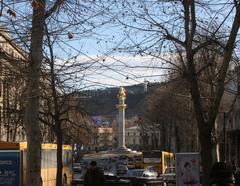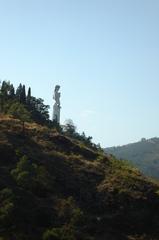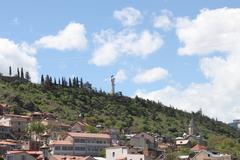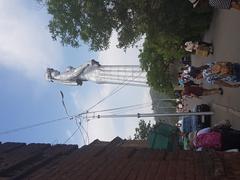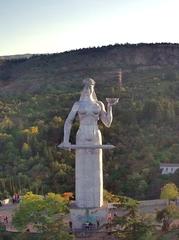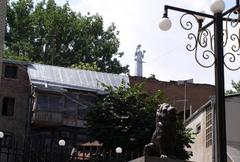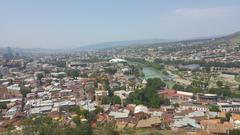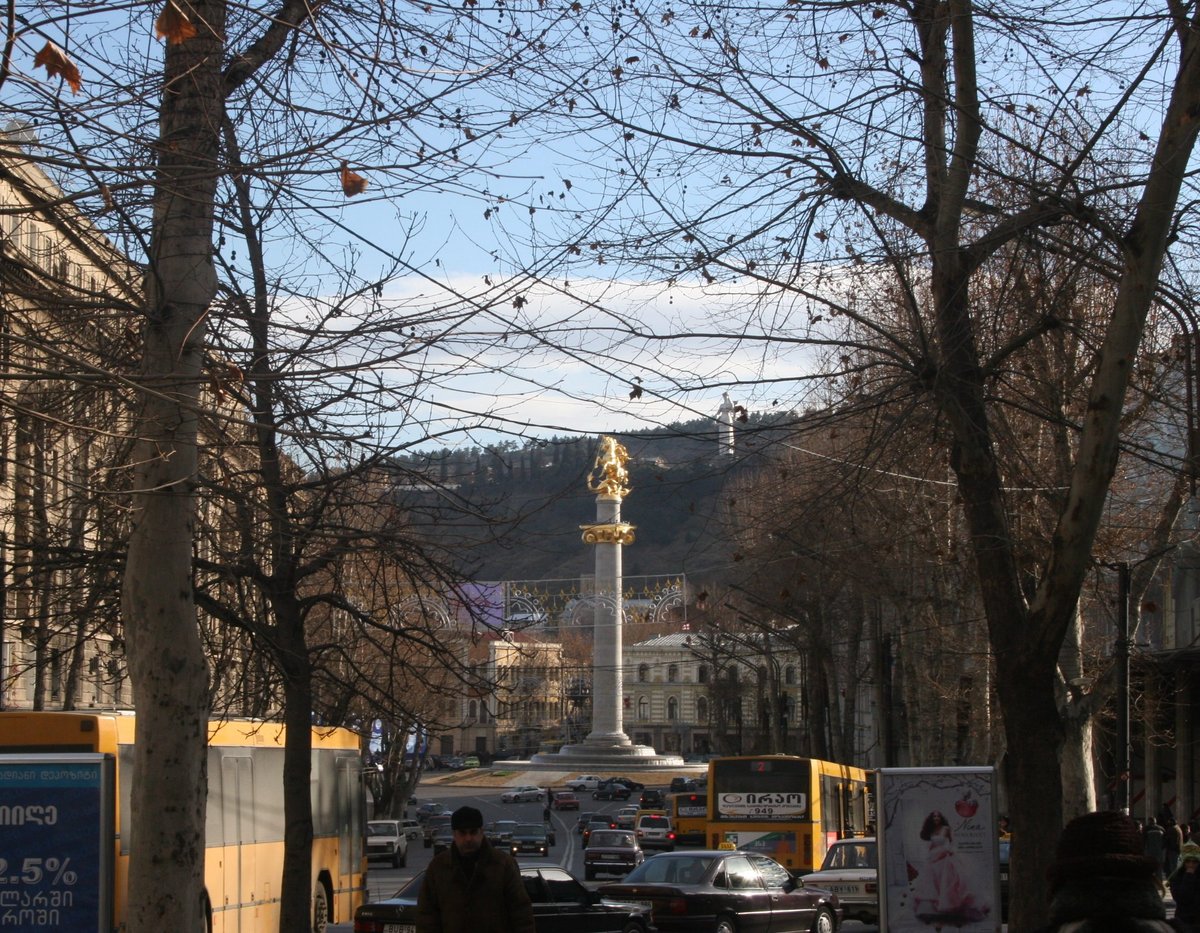
Kartlis Deda Visiting Hours, Tickets, and Historical Significance in Tbilisi
Date: 14/06/2025
Introduction to Kartlis Deda: Tbilisi’s Mother of Georgia
Kartlis Deda, known as the “Mother of Georgia,” is one of the most recognizable symbols of Tbilisi. Erected in 1958 to commemorate the 1,500th anniversary of the city’s founding, this 20-meter-high aluminum statue stands atop Sololaki Hill, keeping watch over the capital. Kartlis Deda was designed by Georgian sculptor Elguja Amashukeli and has since become a powerful emblem of Georgian national identity, reflecting both hospitality and resilience: a bowl of wine in her left hand for friends, and a sword in her right for those who threaten the nation (Wikipedia; Georgia Travel; Holidify).
This guide offers a comprehensive overview of Kartlis Deda’s history, cultural significance, practical visiting information (including hours, ticketing, and accessibility), as well as tips for exploring Tbilisi’s nearby attractions and customs.
Table of Contents
- Introduction
- Origins and Construction
- Symbolism and Artistic Representation
- Historical Context and National Identity
- Visiting Kartlis Deda: Hours, Tickets, and Accessibility
- Nearby Attractions
- Travel Tips and Photographic Spots
- Cultural Significance in Contemporary Georgia
- FAQ
- Conclusion and Call to Action
Origins and Construction
Kartlis Deda was unveiled in 1958, marking Tbilisi’s 1,500th anniversary (Wikipedia; Georgia Travel). Initially constructed in wood, the statue was soon encased in aluminum to withstand the elements. In 1997, a full aluminum replacement was installed to ensure its preservation (Georgia Travel). The statue’s traditional attire and dignified bearing are visible from much of the city, making it both a navigational landmark and a source of local pride (Georgia.to).
Symbolism and Artistic Representation
Kartlis Deda’s design is rich in meaning. Her bowl of wine symbolizes the legendary Georgian hospitality, while her sword stands for the country’s readiness to protect itself. The statue’s serene features and traditional dress reflect national pride, and her posture—facing the city—suggests a guardian watching over Tbilisi (Holidify; Georgian Wine UK).
Historical Context and National Identity
Erected during the Soviet era, Kartlis Deda was an assertion of Georgia’s distinct identity and historical endurance, at a time of political change and challenge. The wine bowl nods to Georgia’s 8,000-year-old winemaking tradition, while the sword acknowledges centuries of defending against invaders. Today, the statue is central to national holidays and public commemorations (Huffington Post; Georgian Wine UK).
Visiting Kartlis Deda: Hours, Tickets, and Accessibility
Visiting Hours
Kartlis Deda is an outdoor monument open 24/7. The surrounding park and panoramic platforms can be visited at any time, but the best hours are during daylight—especially at sunrise or sunset for spectacular city views.
Tickets and Entry
There is no entrance fee to visit Kartlis Deda. Access is entirely free, making this a must-see for budget travelers.
Accessibility
- Cable Car: The easiest way up is by cable car from Rike Park, operating daily from 10:00 AM to 10:00 PM (hours may extend during peak season). The cable car is wheelchair accessible and suitable for most visitors.
- On Foot: A walking path and stairs from the Old Town offer a more strenuous but rewarding approach, passing through historic districts like Betlemi and Abanotubani.
- Taxi/Car: Taxis can deliver you near Narikala Fortress or the cable car station, but cannot access the statue directly due to pedestrian-only zones.
Note: The final approach to the monument involves stairs and uneven ground; those with mobility challenges may wish to use the cable car and view the statue from accessible platforms.
Guided Tours and Events
Numerous Tbilisi walking tours include Kartlis Deda, often paired with Narikala Fortress and the Old Town (Opatrip). During national holidays, the area around the monument becomes a hub of celebration and reflection.
Nearby Attractions
- Narikala Fortress: A short walk from Kartlis Deda, this 4th-century fortress is a must-see for history lovers (Food and Travel Utsav).
- Tbilisi Botanical Garden: Located behind Narikala, home to thousands of plant species and tranquil walking paths (Nomad Epic).
- Abanotubani Sulfur Baths: Historic bathhouses famed for their healing waters—advance booking recommended.
- Tbilisi Old Town: Cobbled streets, vibrant architecture, and landmarks like Sioni Cathedral and Anchiskhati Basilica.
- Bridge of Peace: A striking modern pedestrian bridge, especially beautiful when illuminated at night.
- Mtatsminda Park: Accessible by funicular, offering rides, views, and family activities (MyHolidays).
Travel Tips and Photographic Spots
- Best Time: Early morning or sunset for gentle light and fewer crowds.
- Duration: Spend 30–45 minutes at the site; combine with a walk through Old Town or a visit to Narikala.
- Facilities: There are no restrooms or cafes at the monument; bring water and sun protection.
- Photography: Capture the statue with the cityscape as a backdrop. Morning and evening are best for photos.
- Safety: Stairs can be slippery when wet; use caution.
- Dress Code: Modest attire is appreciated, especially when combining your visit with nearby religious sites.
Cultural Significance in Contemporary Georgia
Kartlis Deda is more than a monument. She is a living symbol of Georgia’s hospitality and tenacity, featured in art, literature, and media. Her image is central to public events and a source of national pride (Huffington Post).
Frequently Asked Questions (FAQ)
Q: What are Kartlis Deda’s visiting hours?
A: The site is accessible 24/7. The cable car operates 10:00 AM–10:00 PM (may vary by season).
Q: Is there an entrance fee?
A: No, visiting Kartlis Deda is free.
Q: How do I reach Kartlis Deda?
A: By cable car from Rike Park, walking from Old Town, or taxi to nearby drop-off points.
Q: Is the monument wheelchair accessible?
A: The cable car is accessible; the final approach involves stairs, so full accessibility is limited.
Q: Are guided tours available?
A: Yes, many local operators include Kartlis Deda in walking tours.
Q: Are there restrooms or cafes at the monument?
A: No, plan ahead as facilities are available only at the cable car station or nearby cafes.
Conclusion and Call to Action
Kartlis Deda is a must-see for anyone visiting Tbilisi. The monument’s symbolism—offering wine to friends and a sword to foes—captures the heart of Georgian culture. With free, all-day access and a choice of scenic approaches, it is an ideal destination for photographers, history enthusiasts, and travelers seeking authentic local experiences.
Enhance your visit by exploring Narikala Fortress, the sulfur baths, and Tbilisi’s vibrant Old Town. For detailed maps, guided audio tours, and the latest travel insights, download the Audiala app. Follow us on social media and read our related articles for more on Georgian history, wine culture, and travel tips.
Visuals and Media Suggestions
- High-resolution photos of Kartlis Deda, especially at sunrise/sunset and with panoramic city views.
- Maps showing access routes from Rike Park and Old Town.
- Short video clips or virtual tours of the hike and cable car ride.
- Alt text for images: “Kartlis Deda statue overlooking Tbilisi,” “Panoramic view from Kartlis Deda,” “Cable car route to Kartlis Deda.”
References and Further Reading
- Kartlis Deda on Wikipedia
- Georgia Travel: Kartlis Deda
- Mother of Georgia - Georgia.to
- Kartlis Deda Sightseeing - Holidify
- Wine Culture History - Georgian Wine UK
- Kartlis Deda: The Important Woman - Huffington Post UK
- Best Places to Visit in Tbilisi - Nomad Epic
- Kartlis Deda - TripHobo
- Must Visit Attractions in Tbilisi - Food and Travel Utsav
- The Best of Tbilisi Walking Tour - Opatrip
- Understanding Traditional Georgian Customs - TripJive
